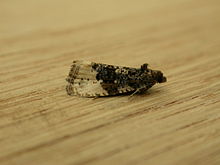
Udea olivalis is a species of moth of the family Crambidae. It was first described by Michael Denis and Ignaz Schiffermüller in 1775 and is found in Europe.

Gypsonoma aceriana, the poplar shoot-borer, is a moth of the family Tortricidae. It is found from Europe to Russia, eastern Turkey and Iraq. It is also present in North Africa.
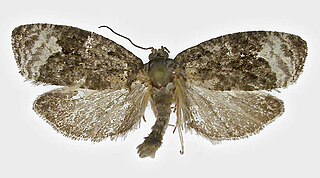
Apotomis capreana is a moth of the family Tortricidae. It is found in most of Europe, east to the eastern part of the Palearctic realm.
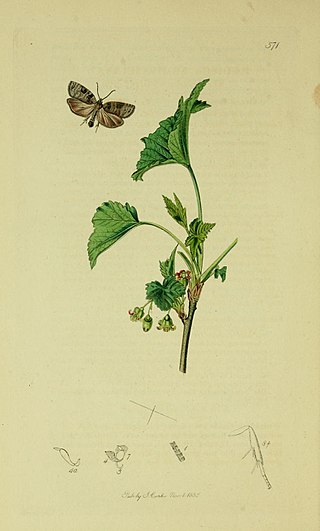
Apotomis semifasciana, the short-barred grey marble, is a moth of the family Tortricidae. It was first described by the English entomologist Adrian Hardy Haworth in 1811.
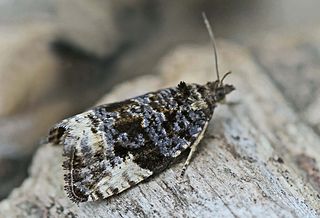
Hedya pruniana, the plum tortrix, is a species of moth of the family Tortricidae. It is found in the Palearctic realm. In central Europe, it is a common species. In the east, the range extends through Anatolia and Iran, the Ural, Transcaucasia and western Kazakhstan to the Far East.

Apotomis betuletana is a moth of the family Tortricidae. It is found in most of Europe. It is also found in the eastern part of the Palearctic realm. The habitat consists of woods and woodland margins where birch occurs.
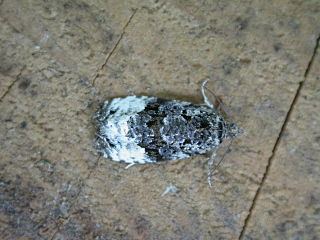
Apotomis sororculana is a moth of the family Tortricidae. It is found in most of Europe, and in the eastern part of the Palearctic realm.

Olethreutes palustrana is a moth of the family Tortricidae. It is found in most of Europe, except the Iberian Peninsula and the Balkan Peninsula. It is also known from the eastern part of the Palearctic realm and North America. The habitat consists of heathland with scattered trees.
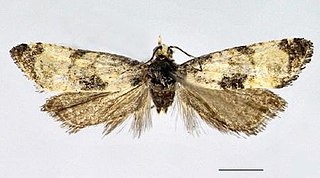
Cochylis dubitana, the little conch, is a moth of the family Tortricidae. It is found in China (Heilongjiang) and most of Europe. and the Caucasus. It is also found in North America, where it has been recorded from Colorado, Maine, Ontario and Washington.

Ancylis myrtillana is a moth of the family Tortricidae. It was described by Treitschke in 1830. It is found in most of Europe and across the Palearctic.It has also been recorded in North America. The habitat consists of moorland.

Cochylis pallidana, the sheep's-bit conch, is a moth of the family Tortricidae. It was described by Zeller in 1847.

Apoctena orthocopa, also known as striped ponga leaf-tyer, is a species of moth of the family Tortricidae. It is endemic to New Zealand, where it is found only on the North Island.

Eucosma aspidiscana, the golden-rod bell, is a species of moth of the family Tortricidae. It is found in China, Mongolia, Korea, Japan, Russia, North Africa and most of Europe. The habitat consists of woodlands, downland, waste grounds and cliffs.

Eucosma cana, the hoary bell, is a species of moth of the family Tortricidae.
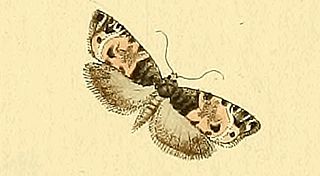
Notocelia incarnatana, the chalk rose bell, is a species of moth of the family Tortricidae. It is found in China, Mongolia, Japan, Russia, Kazakhstan and Europe, where it has been recorded from most of the continent, except parts of the Balkan Peninsula.
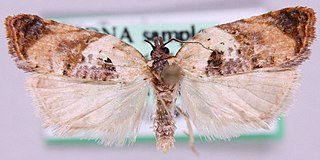
Acleris permutana is a species of moth of the family Tortricidae. It is found in Ireland, Great Britain, Portugal, Spain, France, Belgium, the Netherlands, Germany, Denmark, Sweden, Austria, Italy, the Czech Republic, Slovakia, Slovenia, Croatia, Hungary, Romania, North Macedonia and Russia. The habitat consists of coastal sandhills and limestone.
Depressaria prospicua is a moth in the family Depressariidae. It was described by Edward Meyrick in 1914. It is found in South Africa.

Epinotia abbreviana is a moth of the family Tortricidae. It is found in Europe and was first described by Johan Christian Fabricius in 1794.

Pammene argyrana is a species of moth belonging to the family Tortricidae.

Epiblema costipunctana is a species of moth belonging to the family Tortricidae. It is native to Europe.

